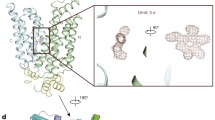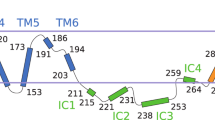Abstract
Glucose transport in plasma membranes is the prototypic example of facilitated diffusion through biological membranes, and transport in erythrocytes is the most widely studied. One of the oldest and simplest models describing the kinetics of the transport reaction is that of alternating conformers, schematized in a cycle of four partial reactions where glucose binds and dissociates at two opposite steps, and the transporter undergoes transconformations at the other two opposite steps. The transport kinetics is entirely defined by the forward and backward rate constants of the partial reactions and the glucose and transporter concentrations at each side of the membrane, related by the law of mass action. We studied, in silico, the effect of modifications of the variables on the transient kinetics of the transport reaction. The simulations took into account thermodynamic constraints and provided results regarding initial velocities of transport, maximal velocities in different conditions, apparent influx and efflux affinities, and the turnover number of the transporter. The results are in the range of those experimentally reported. Maximal initial velocities are obtained when the affinities of the ligand for the transporter are the same at the extra- and intracellular binding sites and when the equilibrium constants of the transconformation steps are equal among them and equal to 1, independently of the obvious effect of the increase of the rate constant values. The results are well adjusted to Michaelis–Menten kinetics. A larger initial velocity for efflux than for uptake described in human erythrocytes is demonstrated in a model with the same dissociation constants at the outer and inner sites of the membrane. The larger velocities observed for uptake and efflux when transport occurs towards a glucose-containing trans side can also be reproduced with the alternating conformer model, depending on how transport velocities are measured.
Similar content being viewed by others
References
Carruthers, A.: Facilitated diffusion of glucose. Physiol. Rev. 70, 1135–1176 (1990)
Lowe, A.G., Walmsley, A.R.: The kinetics of glucose transport in human red blood cells. Biochim. Biophys. Acta 857, 146–154 (1986). doi:10.1016/0005-2736(86)90342-1
Baker, G.F., Widdas, W.F.: Parameters for 2-O-methyl glucose transport in human erythrocytes and fit of asymmetric carrier kinetics. J. Physiol. 395, 57–76 (1988)
Widdas, W.F.: Inability of diffusion to account for placental glucose transfer in the sheep and consideration of the kinetics of a possible carrier transfer. J. Physiol. 118, 23–39 (1952)
Burrows, R.C., Freeman, S.D., Charlop, A.W., Wiseman, R.W., Adamsen, T.C.H., Krohn, K.A., Spence, A.M.: [18F]-2-fluoro-2-deoxyglucose transport kinetics as a function of extracellular glucose concentration in malignant glioma, fibroblast and macrophage cells in vitro. Nucl. Med. Biol. 31, 1–9 (2004). doi:10.1016/S0969-8051(02)00449-3
Hecht, J.P., Nikonov, J.M., Alonso, G.L.: A BASIC program for the numerical solution of the transient kinetics of complex biochemical models. Comp. Prog. Methods Biomed. 33, 13–20 (1990). doi:10.1016/0169-2607(90)90018-5
Cloherty, E.K., Heard, K.S., Carruthers, A.: Human erythrocyte sugar transport is incompatible with available carrier models. Biochemistry 35, 10411–10421 (1996). doi:10.1021/bi953077m
Challis, J.R.A., Taylor, L.R., Holman, G.D.: Sugar transport asymmetry in human erythrocytes—the effect of bulk haemoglobin removal and the addition of methylxanthines. Biochim. Biophys. Acta 602, 155–166 (1980). doi:10.1016/0005-2736(80)90298-9
Dixon, M., Webb, E.C.: Enzymes, 2nd edn. Longmans, London (1964)
Cuppoletti, J.: Transport of ions and nonelectrolytes. In: Sperelakis, N. (ed) Cell physiology—source book, 2nd edn. Academic, San Diego (1995)
Nishimura, H., Pallardo, F.V., Seidner, G.A., Vannucci, S., Simpson, I.A., Birnbaum, M.J.: Kinetics of GLUT1 and GLUT4 glucose transporters expressed in Xenopus oocytes. J. Biol. Chem. 268, 8514–8520 (1993)
Baker, G.F., Widdas, R.J.: The asymmetry of the facilitated transfer system for hexose in human red cells and the simple kinetics of a two component model. J. Physiol. 231, 145–165 (1973)
Braham, J.: Kinetics of glucose transport in human erythrocytes. J. Physiol. 339, 339–354 (1983)
Author information
Authors and Affiliations
Corresponding author
Rights and permissions
About this article
Cite this article
Alonso, G.L., González, D.A. In Silico Kinetic Study of the Glucose Transporter. J Biol Phys 33, 485–498 (2007). https://doi.org/10.1007/s10867-008-9104-1
Received:
Accepted:
Published:
Issue Date:
DOI: https://doi.org/10.1007/s10867-008-9104-1




